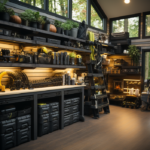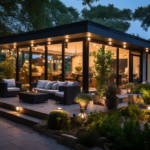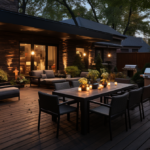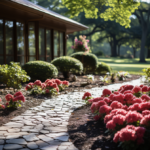Table of Contents
Protecting Your Loved Ones: Discover the Key Safety Enhancements to Safeguard Your Home
Hey there, homeowners! If you’re anything like me, your home is your sanctuary—a place where you should always feel safe and secure. But unfortunately, in today’s world, it’s important to take extra measures to protect ourselves and our loved ones. That’s where essential safety improvements come into play.
In this blog post, we’ll dive into the topic of securing your home with some crucial safety enhancements. From simple fixes to more advanced systems, we’ll cover it all. Whether you’ve just moved into a new place or have been in your home for years, it’s never too late to prioritize the security of your space.
We’ll discuss various aspects of home security, such as reinforcing doors and windows, installing outdoor lighting, investing in a reliable alarm system, and even exploring the world of smart home technology. I’ll break down the pros and cons, costs, and installation processes for each improvement, giving you all the information you need to make informed decisions.
So if you’re ready to take your home security to the next level and enjoy the peace of mind that comes with it, stick around. Together, we’ll ensure that your home becomes a fortress where you can feel safe and protected. Let’s get started!
Reinforcing Doors and Windows
When it comes to securing your home, one of the first areas you should focus on is reinforcing your doors and windows. These are common entry points for burglars, so it’s essential to make them as secure as possible. Here are some key aspects to consider:
- Upgrading Door Locks: Start by evaluating your current locks. Consider replacing them with high-quality deadbolt locks, which provide an added layer of security. Make sure the strike plate is sturdy and properly installed. For sliding glass doors, reinforce them with a bar or rod to prevent forced entry.
- Installing Window Locks and Security Film: Windows are vulnerable, but you can enhance their security with window locks. Install window latches or key-operated locks to prevent them from being easily opened. Another option is to apply security film to the glass. This film makes it more difficult for intruders to break through and provides an extra barrier of protection.
- Reinforcing Door Frames: Strengthening your door frames is crucial. Consider reinforcing them with metal plates or strike plates to reinforce the area around the lock. This makes it harder for someone to kick in the door. Additionally, installing door jammers or security bars can prevent the door from being forced open.
- Securing Sliding Doors: Sliding glass doors can be especially vulnerable, as they can be easily lifted off their tracks. Install a bar in the track or use a charley bar to prevent the door from being forced open. You can also install a pin lock that prevents the door from sliding when it’s not in use.
Remember, reinforcing doors and windows is just one step towards a secure home. Stay tuned for the next section, where we’ll discuss the importance of outdoor lighting and its role in deterring potential intruders.
Installing Outdoor Lighting
Outdoor lighting serves multiple purposes when it comes to home security. Adequate lighting not only helps deter potential intruders by eliminating hiding spots around your property, but it also enhances visibility and safety for you and your family. Here are some essential aspects to consider:
- Motion-Activated Lights: Motion-activated lights are a great investment for your home’s exterior. These lights automatically turn on when they detect movement, alerting you to any activity outside your property. They effectively startle intruders and draw attention to their presence. Install them near entryways, driveways, and other vulnerable areas.
- Pathway and Landscape Lighting: Illuminating your pathways and landscaping not only adds aesthetic appeal but also increases safety after sunset. Well-lit paths make it easier for you and your guests to navigate, reducing the risk of accidents. Consider installing low voltage, energy-efficient LED lights along walkways, stairs, and dark corners of your property.
- Floodlights for Large Spaces: If you have a large backyard or open space, floodlights can be a valuable addition. These powerful lights provide wide-ranging illumination, ensuring that every nook and cranny is well-lit. Look for floodlights with adjustable settings, allowing you to control the intensity and coverage area.
- Smart Outdoor Lighting Systems: Take your outdoor lighting to the next level with smart systems. These automated systems can be controlled remotely via smartphone apps or programmed to turn on and off at specific times. This adds an extra layer of convenience and security, as it gives the illusion of an occupied home even when you’re away.
Remember, when installing outdoor lighting, it’s important to strike a balance between security and energy efficiency. Opt for LED lights that consume less energy and have a longer lifespan. Stay tuned for the next section, where we’ll explore the different types of alarm systems to improve your home’s security.
Investing in a Reliable Alarm System
An alarm system is a crucial component of home security, providing an added layer of protection and peace of mind. With advancements in technology, there are various options to choose from. Here are some essential aspects to consider when investing in a reliable alarm system:
- Types of Alarm Systems: There are several types of alarm systems available, including wired, wireless, and monitored systems. Wired systems require professional installation and are directly connected to your home’s electrical system. Wireless systems are easier to install and offer flexibility. Monitored systems, on the other hand, are connected to a monitoring center that alerts authorities in case of a security breach.
- Door and Window Sensors: Door and window sensors are the backbone of any alarm system. These sensors trigger an alarm when the doors or windows are opened or tampered with. Place these sensors on all entry points, including back doors, basement windows, and even the garage.
- Motion Detectors: Motion detectors are designed to detect movement within a specific area. These can be installed in hallways, large rooms, or areas with valuable assets. Some advanced motion detectors also have pet immunity, so your furry friends won’t trigger false alarms.
- Integration with Smart Home Technology: Consider investing in an alarm system that integrates with smart home technology. This allows you to control and monitor your system remotely via smartphone apps. You can receive real-time notifications, arm or disarm the system, and even view security camera feeds.
- Security Cameras: Adding security cameras to your alarm system provides visual evidence in case of a security breach. Install cameras at strategic locations around your property, such as the front door, backyard, or driveway. Opt for cameras with high resolution and night vision capabilities for clearer footage.
Choosing the right alarm system depends on your budget and specific security needs. Ensure you understand the features and requirements of each system before making a decision. Stay tuned for the next section, where we’ll explore the world of smart home technology and its impact on home security.
Exploring Smart Home Technology
In today’s digital age, smart home technology is revolutionizing the way we secure our homes. With the ability to control and monitor various aspects of your home remotely, smart devices offer convenience and enhanced security. Here are some essential aspects to consider when exploring smart home technology:
- Smart Locks: Smart locks provide a secure and convenient way to manage access to your home. With features like keyless entry, temporary access codes, and remote locking and unlocking capabilities, you can have better control over who enters your home. Some smart locks even integrate with virtual assistants like Alexa or Google Home.
- Security Cameras and Video Doorbells: Smart security cameras and video doorbells allow you to keep an eye on your home no matter where you are. With features like live streaming, motion detection, and cloud storage, you can monitor suspicious activity and even communicate with visitors remotely. Some devices offer facial recognition technology for added security.
- Smart Lighting: Smart lighting systems allow you to control and automate your lights from anywhere. This helps create the illusion of an occupied home, even when you’re away. You can set up schedules, control brightness, and even sync your lights with other security devices to enhance your home security.
- Smart Sensors and Detectors: Smart sensors and detectors offer an extra layer of security. These devices can detect smoke, carbon monoxide, or water leaks and send alerts to your smartphone. You can also integrate these sensors with your smart home security system to trigger alarms or auto dial emergency services.
- Voice-Activated Virtual Assistants: Virtual assistants like Alexa, Google Home, or Siri can help you manage your smart home security devices through voice commands. You can arm or disarm your security system, lock doors, or check camera feeds simply by speaking to your virtual assistant.
As you explore smart home technology, consider compatibility, ease of use, and security features before making any purchases. A well-integrated smart home security system can provide you with unprecedented control and convenience over your home’s security.
Conclusion
In conclusion, securing your home with essential safety improvements is not just a luxury but a necessity in today’s world. By taking proactive measures, you can create a safer environment for yourself and your loved ones. Whether it’s reinforcing doors and windows, installing outdoor lighting, investing in a reliable alarm system, or exploring the world of smart home technology, each aspect plays a crucial role in enhancing home security.
Remember, home security is a multi-layered approach. It’s important to address vulnerabilities from multiple angles to ensure comprehensive protection. Small changes and upgrades can make a significant difference in deterring potential intruders and providing you with peace of mind.
Take the time to assess your home’s security needs, consider your budget, and prioritize the improvements that align with your goals. Consult with professionals if needed, as they can provide expert guidance and ensure proper installation.
Ultimately, by implementing essential safety improvements, you’re not just securing your physical property, but also safeguarding the well-being and happiness of your family. So why wait? Start taking steps today to create a safer and more secure home for yourself and your loved ones.









